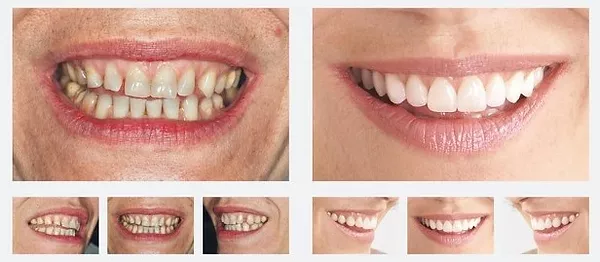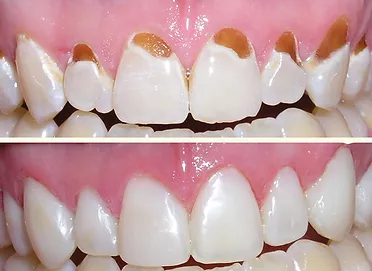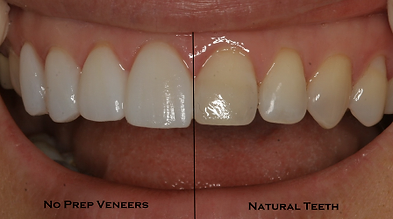A veneer is a thin layer of porcelain or composite material placed over a tooth, either to improve the aesthetics of a tooth or to protect the tooth’s surface from damage.
We are delighted to discuss veneers with you as part of your personal treatment plan. Whether the latest no preparation veneers or traditional bonded veneers are best, we have all the options.
For many years porcelain veneers have been the most commonly provided type of veneer in the UK. Veneers made from porcelain can be used to change the shade, shape, position or size of teeth and also to close or reduce gaps between teeth. For traditional porcelain veneers it is very common to require some preparation of the underlying tooth to create space to place the veneer.
In certain cases, such as where a tooth is being brought forward into the line of the arch or where a small tooth is being made bigger, no preparation may be required. Traditional porcelain veneers are then constructed in a dental laboratory from precision models of your teeth constructed from impressions taken of your mouth.

Dental composite veneers are made using the same type of materials that are used in cosmetic bonding and for many white fillings. Composite veneers are most often provided directly by your dentist at a single visit. The composite is applied to your tooth surface and polished to create the veneer surface. Occasionally composite veneers are made by a dental laboratory and then fitted by your dentist at a second visit.


One of the very latest techniques to emerge has been the no preparation veneer. Advances in porcelain technology allow dental technicians to make extremely thin porcelain veneers that can be bonded to teeth without any tooth removal being required.
We offer no preparation veneers as part of our comprehensive range of treatments. Our dentists can discuss these with you as part of your custom treatment plan.
Obviously it is a good thing not to have to remove tooth tissue; however as this is a very new technique there are no longer term scientific studies to show what the long term survival of these veneers are.
When a tooth has lost a significant amount of its structure one of the options for treatment, rather than a conventional filling, can be an inlay or onlay. An inlay fits into the tooth whilst an onlay also covers the top biting surface of the tooth. Both inlays and onlays are usually manufactured in a dental laboratory using precision models of your teeth. They are used when a dentist thinks a direct filling will not offer enough protection to the tooth in the long term.
Your dentist will evaluate your tooth first to ensure the remaining tooth tissue is healthy enough for your inlay or onlay. Your dentist will also ensure that you have enough tooth tissue left so that an inlay or onlay restores your tooth’s appearance and function for many years to come.
Your inlay or onlay can be made up of one of four materials.
This tooth coloured alternative has been used for both inlays and onlays for many years. It can give a very lifelike result but may require more preparation of the remaining tooth than other choices. Wear of opposing teeth, because of the abrasive qualities of certain porcelains, is also an important factor when planning this restoration.
Special gold alloys are utilised which can still be gold coloured but are harder than pure gold. Gold is an excellent choice for an inlay or onlay due to its long term stability and high survival rate in the mouth. The amount of tooth preparation required can also be less than for a porcelain inlay or onlay. However, the disadvantage of gold is due to its colour. Many people would prefer a tooth coloured alternative instead, but remember many dentists still choose gold for inlays or onlays in their own mouths.
Inlays and onlays can be constructed in composite resin. This is a tooth coloured filling material and it is usually pressure cured in the dental laboratory to give it optimum strength. There are less long term studies regarding composite, but initial findings suggest that it has a similar lifespan to porcelain inlays or onlays. Many dentists like composite inlays and onlays because they are much less abrasive than porcelain and so kinder to the opposing teeth.
Using Computer Aided Design Computer Aided Manufacture (CADCAM) equipment it is possible to mill zirconia into inlays and onlays. This tooth coloured ceramic is exceptionally tough and resilient and studies suggest that its resistance to fracture in laboratory conditions is better than any other tooth coloured inlay and onlay material.



| Cookie | Duration | Description |
|---|---|---|
| cookielawinfo-checkbox-analytics | 11 months | This cookie is set by GDPR Cookie Consent plugin. The cookie is used to store the user consent for the cookies in the category "Analytics". |
| cookielawinfo-checkbox-functional | 11 months | The cookie is set by GDPR cookie consent to record the user consent for the cookies in the category "Functional". |
| cookielawinfo-checkbox-necessary | 11 months | This cookie is set by GDPR Cookie Consent plugin. The cookies is used to store the user consent for the cookies in the category "Necessary". |
| cookielawinfo-checkbox-others | 11 months | This cookie is set by GDPR Cookie Consent plugin. The cookie is used to store the user consent for the cookies in the category "Other. |
| cookielawinfo-checkbox-performance | 11 months | This cookie is set by GDPR Cookie Consent plugin. The cookie is used to store the user consent for the cookies in the category "Performance". |
| viewed_cookie_policy | 11 months | The cookie is set by the GDPR Cookie Consent plugin and is used to store whether or not user has consented to the use of cookies. It does not store any personal data. |